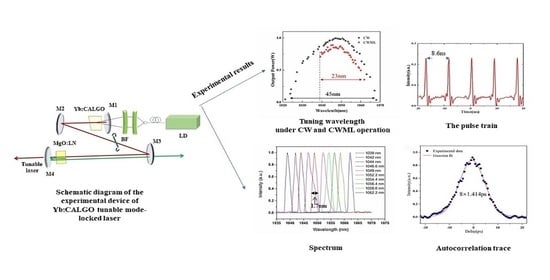Wavelength-Tunable Nonlinear Mirror Mode-Locked Laser Based on MgO-Doped Lithium Niobate
Abstract
:1. Introduction
2. Materials and Methods
3. Results
4. Discussion
5. Conclusions
Author Contributions
Funding
Acknowledgments
Conflicts of Interest
References
- Baxter, J. Optical coherence tomography: Tunable for medicine. Nat. Photonics 2012, 6, 70. [Google Scholar]
- Malinauskas, M.; Žukauskas, A.; Hasegawa, S.; Hayasaki, Y.; Mizeikis, V.; Buividas, R.; Juodkazis, S. Ultrafast laser processing of materials: From science to industry. Light Sci. Appl. 2016, 5, e16133. [Google Scholar] [CrossRef] [PubMed] [Green Version]
- Zhang, F.; Wu, Y.J.; Liu JPang, S.Y.; Ma, F.K.; Jiang, D.P.; Wu, Q.H.; Su, L.B. Mode locked Nd3+ and Gd3+ co-doped calcium fluoride crystal laser at dual gain lines. Opt. Laser Technol. 2018, 100, 294–297. [Google Scholar] [CrossRef]
- Nie, W.; Jiang, S.; Li, R.; Ren, F.; Clayton, A.H.A.; Juodkazis, S.; Chen, F. Plasmon-induced photoluminescence and Raman enhancement in Pr:CaF2 crystal by embedded silver nanoparticles. Appl. Surf. Sci. 2020, 530, 147018. [Google Scholar] [CrossRef]
- Zhang, F.; Zhu, H.; Liu, J.; He, Y.; Jiang, D.; Tang, F.; Su, L. Tunable Yb: CaF2–SrF2 laser and femtosecond mode-locked performance based on semiconductor saturable absorber mirrors. Appl. Opt. 2016, 55, 8359–8362. [Google Scholar] [CrossRef] [PubMed]
- Lin, H.; Zhang, G.; Zhang, L.; Lin, Z.; Pirzio, F.; Agnesi, A.; Petrov, V.; Chen, W. Continuous-wave and SESAM mode-locked femtosecond operation of a Yb:MgWO4 laser. Opt. Express 2017, 25, 11827–11832. [Google Scholar] [CrossRef] [PubMed]
- Kivisto, S.; Hakulinen, T.; Kaskela, A.; Aitchison, B.; Brown, D.P.; Nasibulin, A.G.; Kauppinen, E.I.; Harkoen, A.; Okhotnikov, O.G. Carbon nanotube films for ultrafast broadband technology. Opt. Express 2009, 17, 2358–2363. [Google Scholar] [CrossRef] [PubMed]
- Sun, Z.; Hasan, T.; Torrisi, F.; Popa, D.; Privitera, G.; Wang, F.; Bonaccorso, F.; Basko, D.M.; Ferrari, A.C. Graphene Mode-Locked Ultrafast Laser. ACS Nano 2010, 4, 803–810. [Google Scholar] [CrossRef] [Green Version]
- Stankov, K.A.; Jethwa, J. A new mode-locking technique using a nonlinear mirror. Opt. Commun. 1988, 66, 41–46. [Google Scholar] [CrossRef]
- Cerullo, G.; Danailov, M.B.; De Silvestri, S.; Laporta, P.; Magni, V.; Segala, D.; Taccheo, S. A diode-pumped nonlinear mirror mode-locked Nd:YAG laser. Appl. Phys. Lett. 1994, 65, 2392–2394. [Google Scholar] [CrossRef]
- Agnesi, A.; Pennacchio, C.; Reali, G.C.; Kubecek, V. High-power diode-pumped picosecond Nd3+:YVO4 laser. Opt. Lett. 1997, 22, 1645–1647. [Google Scholar] [CrossRef]
- Agnesi, A.; Lucca, A.; Reali, G.; Tomaselli, A. All-solid-state high-repetition-rate optical source tunable in wavelength and in pulse duration. J. Opt. Soc. Am. B 2001, 18, 286–290. [Google Scholar] [CrossRef]
- Saikawa, J.; Taira, T. Second-harmonic nonlinear mirror CW mode locking in Yb:YAG microchip lasers. Jpn. J. Appl. Phys. 2003, 42, L649–L651. [Google Scholar] [CrossRef]
- Thomas, G.M.; Bauerle, A.; Farrell, D.J.; Damzen, M.J. Nonlinear mirror modelocking of a bounce geometry laser. Opt. Express 2010, 18, 12663–12668. [Google Scholar] [CrossRef] [PubMed]
- Thomas, G.M.; Chard, S.P.; Damzen, M.J. High power modelocking of a stigmatic bounce geometry laser using a nonlinear mirror. Appl. Phys. B 2010, 101, 553–557. [Google Scholar] [CrossRef]
- Thomas, G.M.; Omatsu, T.; Damzen, M.J. High-power neodymium-doped mixed vanadate bounce geometry laser, mode locked with nonlinear mirror. Appl. Phys. B 2012, 108, 125–128. [Google Scholar] [CrossRef]
- Iliev, H.; Chuchumishev, D.; Buchvarov, I.; Petrov, V. Passive mode-locking of a diode-pumped Nd:YVO4 laser by intracavity SHG in PPKTP. Opt. Express 2010, 18, 5754–5762. [Google Scholar] [CrossRef]
- Iliev, H.; Buchvarov, I.; Kurimura, S.; Petrov, V. High-power picosecond Nd:GdVO4 laser mode locked by SHG in periodically poled stoichiometric lithium tantalite. Opt. Lett. 2010, 35, 1016–1018. [Google Scholar] [CrossRef]
- Iliev, H.; Buchvarov, I.; Kurimura, S.; Petrov, V. 1.34-mum Nd:YVO4 laser mode-locked by SHG-lens formation in periodically-poled stoichiometric lithium tantalite. Opt. Express 2011, 19, 21754–21759. [Google Scholar] [CrossRef] [Green Version]
- Liu, Y.H.; Xie, Z.D.; Pan, S.D.; Lv, X.J.; Yuan, Y.; Hu, X.P.; Lu, J.; Zhao, L.N.; Chen, C.D.; Zhao, G.; et al. Diode-pumped passively mode-locked Nd:YVO4 laser at 1342 nm with periodically poled LiNbO3. Opt. Lett. 2011, 36, 698–700. [Google Scholar] [CrossRef]
- Lin, S.; Huang, C.H. Effects of nonlinear phase in cascaded mode-locked Nd:YVO4 laser. Opt. Express 2019, 27, 504–511. [Google Scholar] [CrossRef] [PubMed]
- Cheng, H.; Jiang, X.D.; Hu, X.P.; Zhong, M.L.; Lv, X.J.; Zhu, S.N. Diode-pumped 1988-nm Tm:YAP laser mode-locked by intracavity second-harmonic generation in periodically poled LiNbO3. Opt. Lett. 2014, 39, 2187–2190. [Google Scholar] [CrossRef] [PubMed]
- Saltarelli, F.; Diebold, A.; Graumann, I.J.; Phillips, C.R.; Keller, U. Modelocking of a thin-disk laser with the frequency-doubling nonlinear-mirror technique. Opt. Express 2017, 25, 23254–23266. [Google Scholar] [CrossRef] [PubMed]
- Graumann, I.; Saltarelli, F.; Lang, L.; Wittwer, V.J.; Sudmeyer, T.; Phillips, C.R.; Keller, U. Power-scaling of nonlinear-mirror modelocked thin-disk lasers. Opt. Express 2019, 27, 37349–37363. [Google Scholar] [CrossRef] [PubMed]
- Petit, J.; Goldner, P.; Viana, B. Laser emission with low quantum defect in Yb:CaGdALO4. Opt. Lett. 2005, 30, 1345–1347. [Google Scholar] [CrossRef]
- Cerullo, G.; Magni, V.; Monguzzi, A. Group-velocity mismatch compensation in continuous-wave lasers mode locked by second-order nonlinearities. Opt. Lett. 1995, 20, 1785–1787. [Google Scholar] [CrossRef]
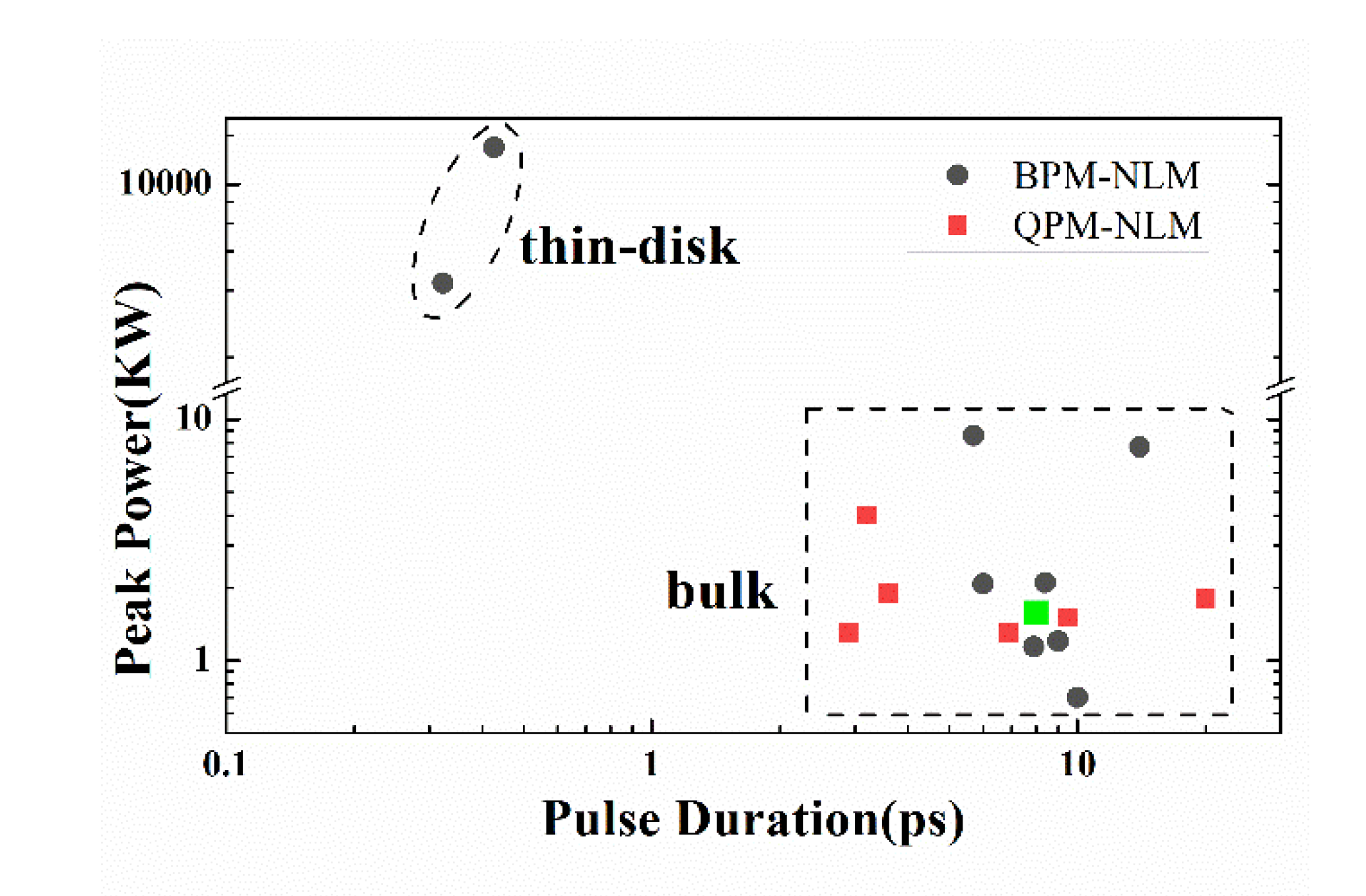
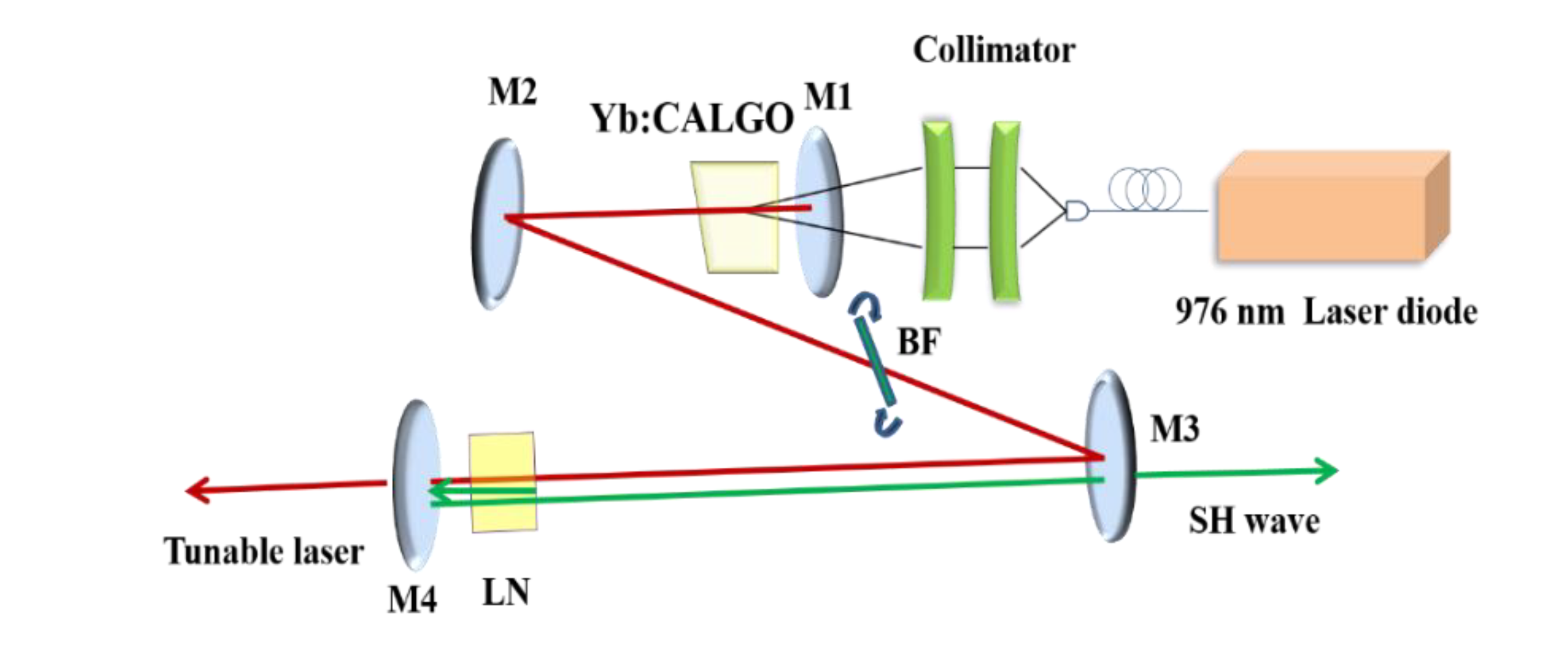
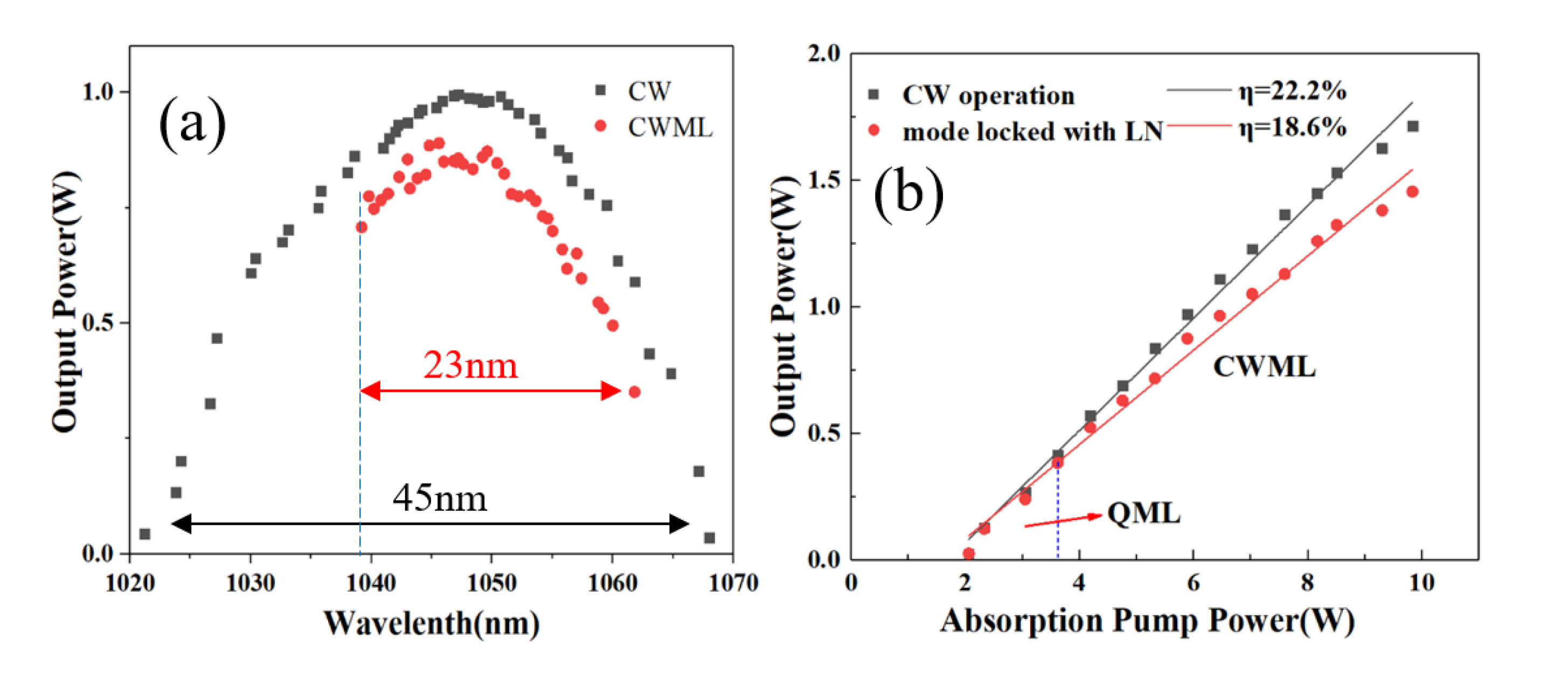

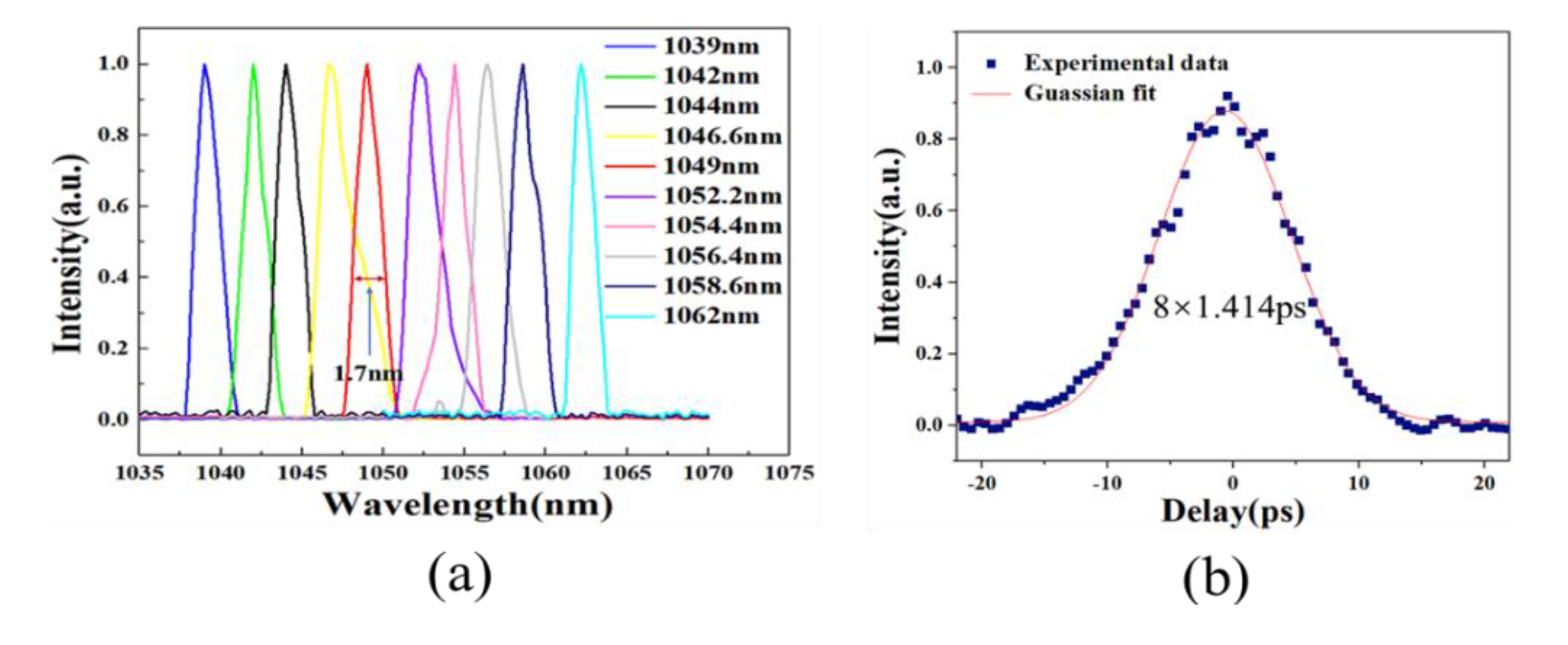
| Nonlinear Crystal | Phase Matching Method | Laser Crystal | Laser Output Characteristics | Reference | Year | ||||
|---|---|---|---|---|---|---|---|---|---|
| Wavelength (nm) | Pulse Width (ps) | Repetition Rate (MHz) | Power | Peak Power (kW) | |||||
| LBO | BPM | Nd:YAG | 1064 | 10 | 100 | 0.7 W | 0.7 kW | [10] | 1994 |
| KTP | BPM | Nd:YVO4 | 1064 | 7.9 | 150 | 1.35 W | 1.14 kW | [11] | 1997 |
| LBO | BPM | Nd:YVO4 | 1064 | 6 | 200 | 2.5 W | 2.08 kW | [12] | 2001 |
| LBO | BPM | Yb:YAG | 1031 | 9 | 82 | 0.9 W | 1.2 kW | [13] | 2003 |
| KTP | BPM | Nd:GdVO4 | 1063 | 57 | 137 | 11.3 W | 1.4 kW | [14] | 2010 |
| BiBO | BPM | Nd:GdVO4 | 1063 | 5.7 | 144 | 7.1 W | 8.6 kW | [14] | 2010 |
| BiBO | BPM | Nd:YVO4 | 1064 | 14 | 110 | 12 W | 7.7 kW | [15] | 2010 |
| BiBO | BPM | Nd:GdVO4 | 1063 | 12.7 | 100 | 16.8 W | 13 kW | [16] | 2012 |
| BBO | BPM | TD-Yb:YAG | 1030 | 0.323 | 17.8 | 21 W | 3.6 MW | [22] | 2017 |
| BBO | BPM | TD-Yb:YAG | 1030 | 0.426 | 9.3 | 66 W | 16.7MW | [23] | 2019 |
| PPKTP | QPM | Nd:YVO4 | 1064 | 2.9 | 117 | 0.5 W | 1.3 kW | [17] | 2010 |
| PPMgSLT | QPM | Nd:GdVO4 | 1064 | 3.2 | 107 | 1.4 W | 4 kW | [18] | 2010 |
| PPMgSLT | QPM | Nd:YVO4 | 1342 | 3.6 | 120 | 0.8 W | 1.9 kW | [19] | 2011 |
| PPLN PPLN MgO:LN | QPM QPM BPM | Nd:YVO4 Nd:YVO4 Yb:CALGO | 1342 1064 1039−1062 | 9.5 2.8 8 | 101 186 115.5 | 1.52W 1.3 W 1.46 W | 1.5 kW 2.49 kW 1.58 kW | [20] [21] Our work | 2011 2019 |
© 2020 by the authors. Licensee MDPI, Basel, Switzerland. This article is an open access article distributed under the terms and conditions of the Creative Commons Attribution (CC BY) license (http://creativecommons.org/licenses/by/4.0/).
Share and Cite
Zhao, L.; Tong, L.; Cai, F.; Yuan, Y.; Cai, Y. Wavelength-Tunable Nonlinear Mirror Mode-Locked Laser Based on MgO-Doped Lithium Niobate. Crystals 2020, 10, 861. https://doi.org/10.3390/cryst10100861
Zhao L, Tong L, Cai F, Yuan Y, Cai Y. Wavelength-Tunable Nonlinear Mirror Mode-Locked Laser Based on MgO-Doped Lithium Niobate. Crystals. 2020; 10(10):861. https://doi.org/10.3390/cryst10100861
Chicago/Turabian StyleZhao, Lina, Luyang Tong, Fangxin Cai, Ye Yuan, and Yangjian Cai. 2020. "Wavelength-Tunable Nonlinear Mirror Mode-Locked Laser Based on MgO-Doped Lithium Niobate" Crystals 10, no. 10: 861. https://doi.org/10.3390/cryst10100861




